What is the best motorcycle helmet?
Published on: 21 November 2021
A question that gets asked a lot on the internet is: “What’s the best helmet?” Or: “Who makes the best helmet?”
Well, we can understand why people might ask this question. But of course the question is a bit simplistic. It’s akin, perhaps, to asking who makes the best motorbike. Ask 10 experts and you will get at least 10 different answers. Probably more!
So one has to ask what do we mean by ‘best’. Are we talking about the safest helmet? The quietest helmet? The most reliable? The most versatile? The best vented helmet? The most comfortable? And so on. And are we talking about open-face helmets, full-face helmets, flip-lids, adventure helmets, race helmets or, for example, pure off-road helmets?
We also have to take into account that one man’s meat is another man’s poison. What I look for in a helmet may not be what you are looking for.
The other truth here is that the best helmet in the world may not be for you if it doesn’t fit you. A lot of people measure their heads and think that they can choose whatever helmet they like the look of based on that measurement. But that’s not the case. Look at these two heads below. They both measure exactly the same measurement around the circumference of their skulls. Yet it must be clear to anybody that the helmet that works perfectly on Mr. Ovalhead is not going to work at all well on Mr. Roundhead. Mr. Ovalhead will find Mr. Roundhead’s perfect helmet awfully tight on his forehead. Whereas Mr. Roundhead will find that Mr. Ovalhead’s perfect helmet incredibly restrictive at the sides. And that’s just in the horizontal plane. Then there’s the shape of the skull in the vertical plane. Not to mention the shape of the face. If you want to understand sizing up for a helmet then read our guide to helmet measurement and sizing.
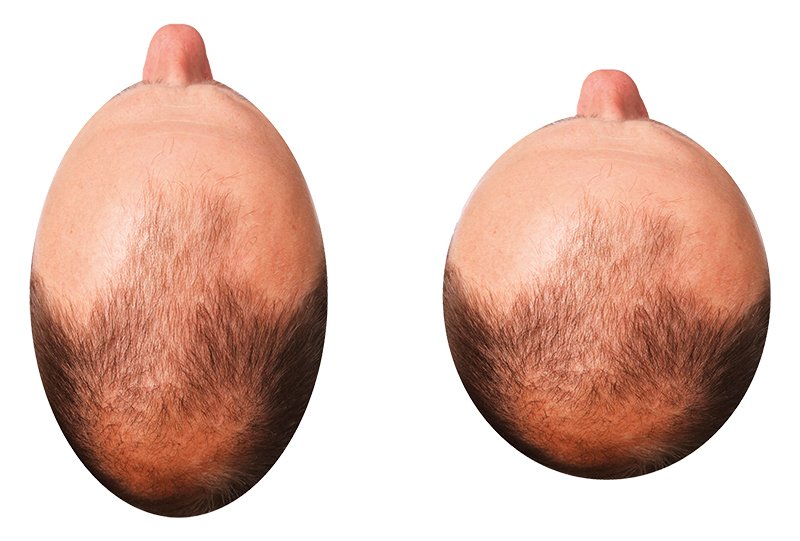
And what this sets up is the reality that the best motorcycle helmet in the world might not fit you and might not work for you. Nevertheless, fit aside, we think we feel up to the task of being able to give a reasonably definitive answer to this question: “Who makes the best helmet?”
As we have suggested, there are lots of criteria that could be applied to this quest for motorcycling’s holy grail.
But we are going to be bold and suggest that, when people ask this question, they are normally asking who makes the safest motorcycle helmet, because protection is a helmet’s primary function. They might, conceivably, also be asking who makes the best quality, most dependable and reliable motorcycle helmet. And, somewhat obliquely, I will address this too.
But before we get into this, let me put to rest a few urban myths.
Some people think that because all helmets are tested to the same ECE 22-05 standard, they are all as safe as one another. But that’s like saying that because all riders have got the same licence, we are all just as competent as one another on the road. The paperwork and the exam may be the same for everyone. But that’s where the similarities end.
ECE 22-05 is a minimum standard. Frankly, it was never a particularly demanding standard. (22-06 is more demanding, but that’s another subject). And as Lidl have shown us, you can get a £25 helmet through 22-05.
But there is a huge difference between those helmets that just meet the standard and those that fly through it. The cheapest helmets might just get over the line, although even then a recent report by an Italian consumer magazine did show that many helmets bought in shops no longer met the standard they were accredited to. And that’s because there are no obligations upon manufacturers to re-test production helmets once the prototype has been approved. If a factory cuts corners on materials, nobody will ever know!
By contrast, the premium brands re-test helmets continually as they come off the production line. And if a helmet from that manufacturing batch is found to have failed in some way, that whole batch will be destroyed.
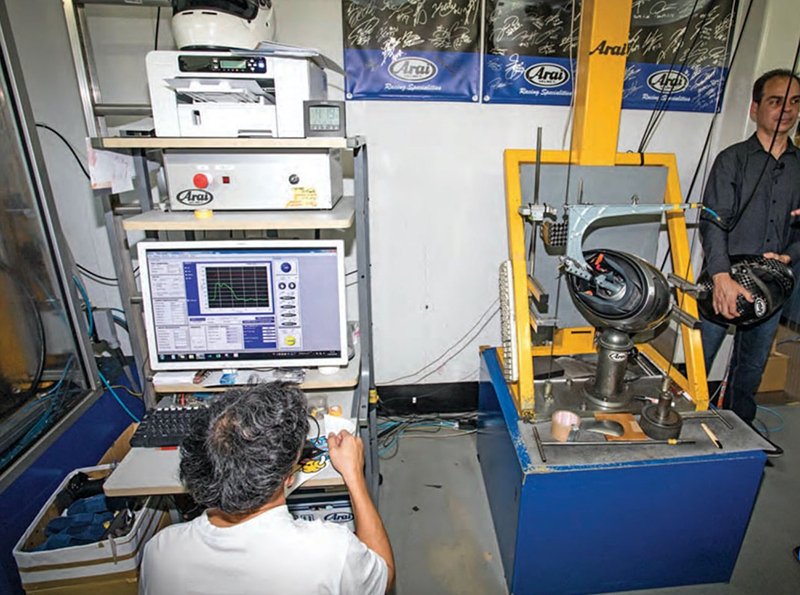
The brands at the top of the tree, of course, also test to a significantly higher standard than 22-05. Indeed, some test to a standard that is even higher than the new 22-06 standard.
The cheapest helmets on the market are made with what is known as a polycarbonate shell; basically plastic. These helmets might pass the test, but their soft shells can easily crack and deform in an accident, leaving the rider less protected in a situation where an accident involves more than one impact. One up from polycarbonate or thermo-injected helmets are fibreglass helmets. They’re better but not out of the top drawer.
It would not be unfair to suggest that the best, most protective helmets on the market will be made with ‘composite’ shells. Now this form of construction covers a hugely wide range of different technologies, but basically composite shells comprise a combination of fibreglass and carbon or Kevlar strands or layers.
Which brings us to the next urban myth; the perceived superiority of carbon helmets. They must surely be safer, people assume, because that’s what Moto GP riders wear. Well, I’m afraid not. Carbon helmets are lighter, not stronger. And if you’re a racer, weight is everything. Less weight is more speed, but a lighter helmet also puts less strain on a rider’s neck because of the G-forces that apply. This is why racers wear carbon helmets.
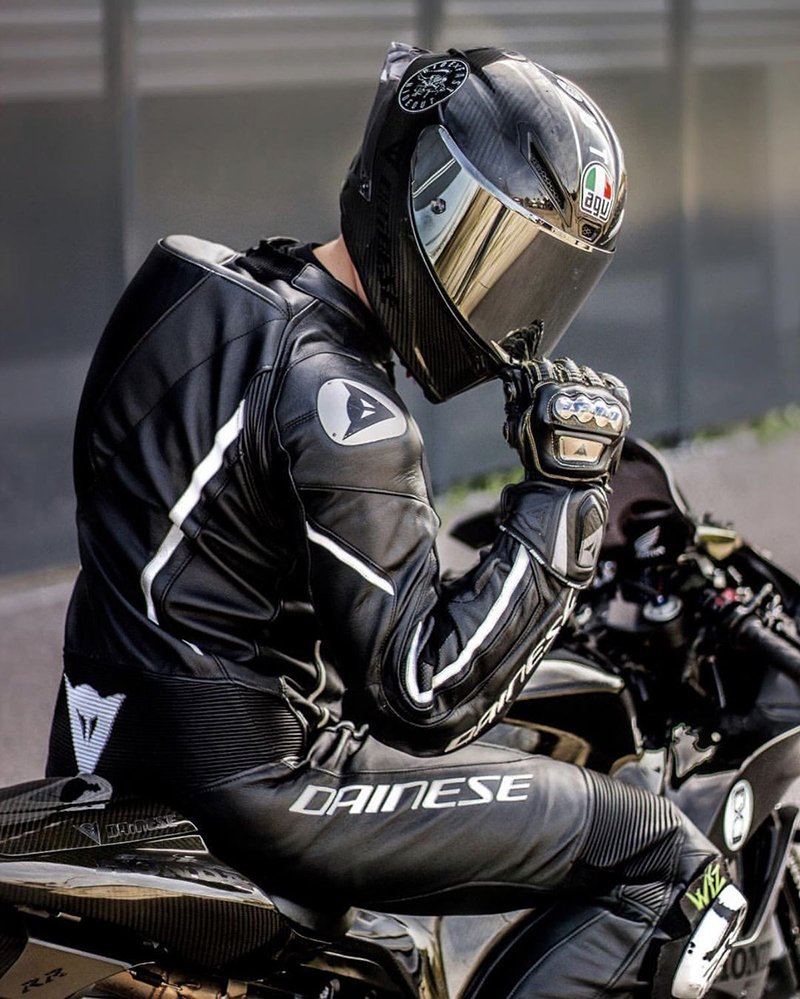
As a road rider, you might buy a carbon helmet for a number of reasons. You might have a carbon fetish, and feel that a carbon lid will go well with all the carbon-fibre bodywork panels on your bike. You might feel that you ride so hard that the weight saving will save your neck muscles. (Who are you kidding)? You might want to show off that you can afford something really expensive. You might choose a carbon helmet for all kinds of reasons, but if you thought you were buying a safer helmet because it is carbon, you would be wrong. Sorry!
Let me now touch upon my final urban myth; that SHARP can guide you towards a safer helmet. The SHARP test regime is one that many people hold dear. And they hold it dear because people can be lazy, and sometimes want someone else to make their decisions for them. And if you only eat in restaurants that come top on Tripadvisor, be my guest, buy a helmet with five SHARP stars. But SHARP carries little weight within the industry. There’s only one brand out there that uses SHARP in its marketing, and that’s because the SHARP testing methodology just happens to suit their helmet construction.
Very briefly, SHARP was formed as a result of the UK going into the EU. The guys who had been doing the BSI helmet testing suddenly found themselves with some test equipment and loads of spare white coats, but no jobs. They lobbied the government for money citing a European Commission report called COS 327. They suggested that they could devise a methodology that would allocate stars to helmets based on how much better they performed than the base 22-05 level.
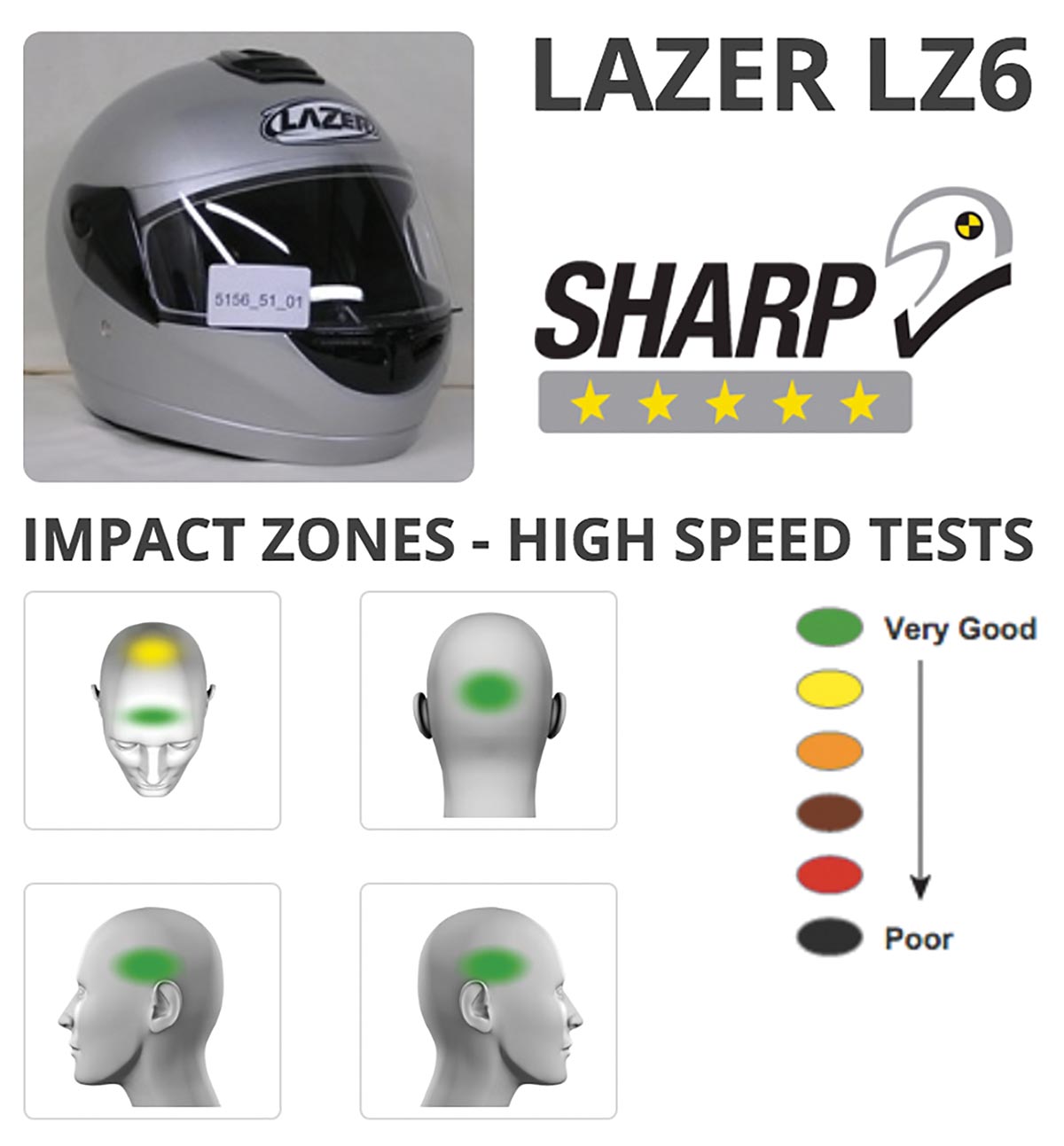
The problem was that they cut corners to save money, and created a test standard that had not been independently reviewed. They used cheap steel headforms, for example, rather than the expensive biometric headforms that had been stipulated in the report. In their first round of tests, SHARP gave five stars to a £60 polycarbonate helmet from Lazer and three stars to an Arai. From that point on, nobody in the industry took SHARP particularly seriously. If you are still choosing your helmets on the basis of SHARP, therefore, you will be missing a trick.
There are a couple of dozen serious players in this market. We are going to ignore the real cheapie brands to be found in scooter shops, hipster emporiums and discount warehouses. Nobody is going to seriously think that anybody who specialises in helmets below £200 is a contender for the title: “Best Motorcycle Helmet”.
The kind of names we are talking about appear below. I apologise if I have missed any brands out. This is not intentional and not meant as a slur, but it is not material in that I already know the answer to the original question, and I know that that that company does appear on the list!
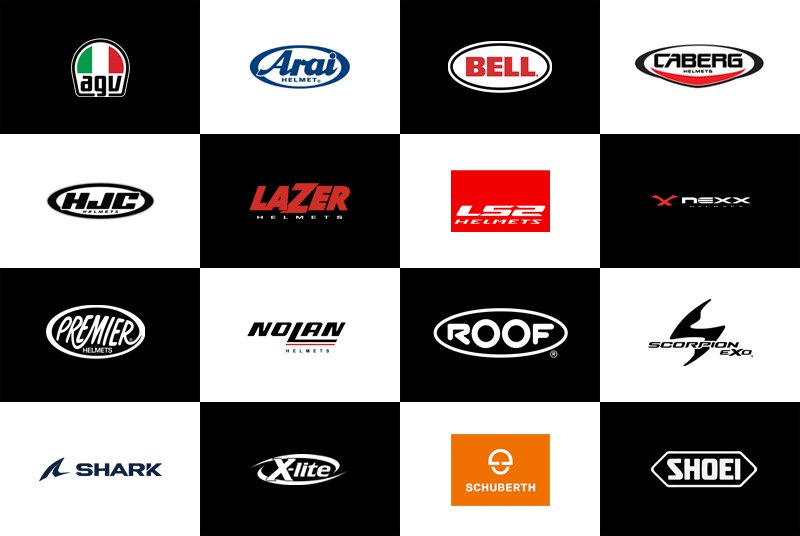
Now I do not wish to get into a debate, about whether any one particular brand is better or safer than another. The truth is that it will nearly always be impossible to answer such a question. I have sat in a number of helmet factories, and in every case the person I have sat opposite has tried to convince me that their helmets were the best, that their quality control procedures were more rigorous, and that their testing was conducted to a higher standard. Their aim has invariably been to blind me with the science. And I would say that they have usually succeeded.
Every manufacturer can talk about features that distinguish their helmets; be it MIPS, softer shells, harder shells, multi-layer eps liners, patented technologies, Moto GP experience or whatever. I think all of the brands I have listed here have the wherewithal to make proper helmets that can be relied upon.
If I were asked, I think I could create some form of brand map where some brands would sit above a quality line and others below. But I could never be sure that I had got it right, and if I published my views it wouldn’t be long before the lawyers’ letters started to accumulate on the stoop.
But there are two brands that stand out from the crowd. And I do not believe that anybody who works in the motorcycle industry would really disagree that these two brands sit at a higher level. Of course, those associated with other brands would publicly have to protest, although I fear they would be protesting too much. And quietly, off camera, even the most ardent partisan would have to acknowledge the truth of the fact regarding my two candidates.
Our two candidates, predictably perhaps for those who work in motorcycling, are the two Japanese giants Arai and Shoei. Both these companies have been producing helmets since the 1950s; Arai from the early part of that decade; Shoei from the latter.

They both test to a standard that far exceeds the ECE standard. And as you might expect of Japanese companies, their quality control systems and procedures put them in a different league to other brands. Technically, their helmets are from the top drawer. And they have both been involved in the highest echelons of motorsport for over 50 years.
Now we are not necessarily taken in by brands who climb the ladder to fame solely on the back of their participation in motorsport. It is a well-worn and easy, although potentially expensive, way to get to the top. As a consumer, choosing your helmet based solely on the basis that it has been worn by a famous rider seems lazy, in our view. A helmet appears on the head of a rider on TV. It becomes famous as a result, but the question always has to be whether that rider is wearing that helmet because he thinks it’s the best or because he gets a huge cheque for doing so. You don’t have to be Einstein to work it out.
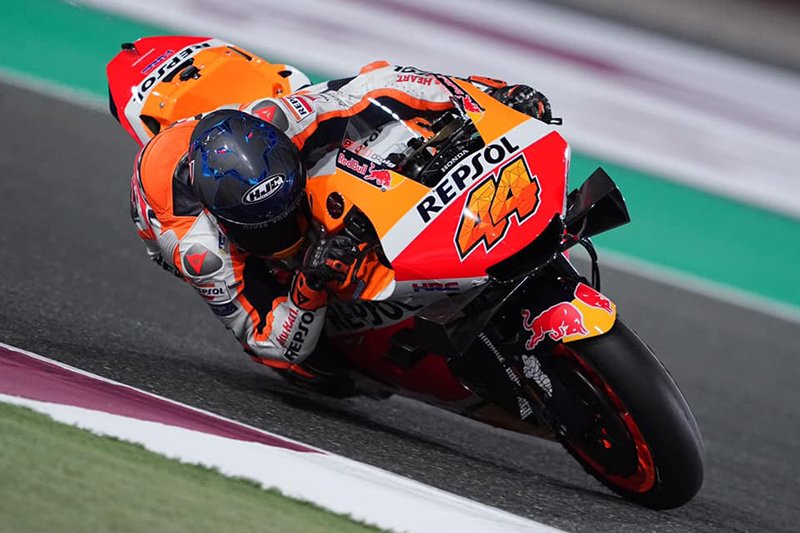
But whilst Arai and Shoei both also undoubtedly pay riders a lot of money to wear their helmets, they have not used motorsport as a quick way to get rich. Both these companies have been intimately involved in motorsport and the safety of riders ever since they became involved in the sport at the end of the sixties. No two companies have done more to protect racers, and to define the modern helmet than these two companies.
It was of no surprise to us that, when the new 22-06 safety standard was introduced, it was Arai and Shoei who were first to market with approved helmets. And that was partly because both were already testing to a far higher standard than 22-05, but also because they were the standard bearers for the new Moto GP, FIM standard, on which 22-06 was based.
As an indicator of the superiority of these two brands, you might be interested to know that when the new FIM helmet standard was introduced for the 2018 season, a number of the participating helmet manufacturers were so technically challenged that they were not able to produce helmets to the required level. And so a number of riders wore Arai and Shoei helmets rebranded with the logo of the brand they usually wore. We’re not attempting to embarrass anybody here, but this does perhaps go some way towards demonstrating how far ahead of the pack the two Japanese brands are.
On one level this might appear as little more than salacious gossip, although the truth is out there for all to see in glorious technicolour. But I cite this fact because it is an incontrovertible demonstration of the unimpeachable and unmatchable safety credentials of these two brands. But it might be the case that I am guilty of protesting too much, for actually nobody who knows or understands is going to really take issue with where we have got to so far.
The next bit, however, might be a bit more controversial.
Arai is an uncompromising company, ruled by the iron rod that is Michio Arai.
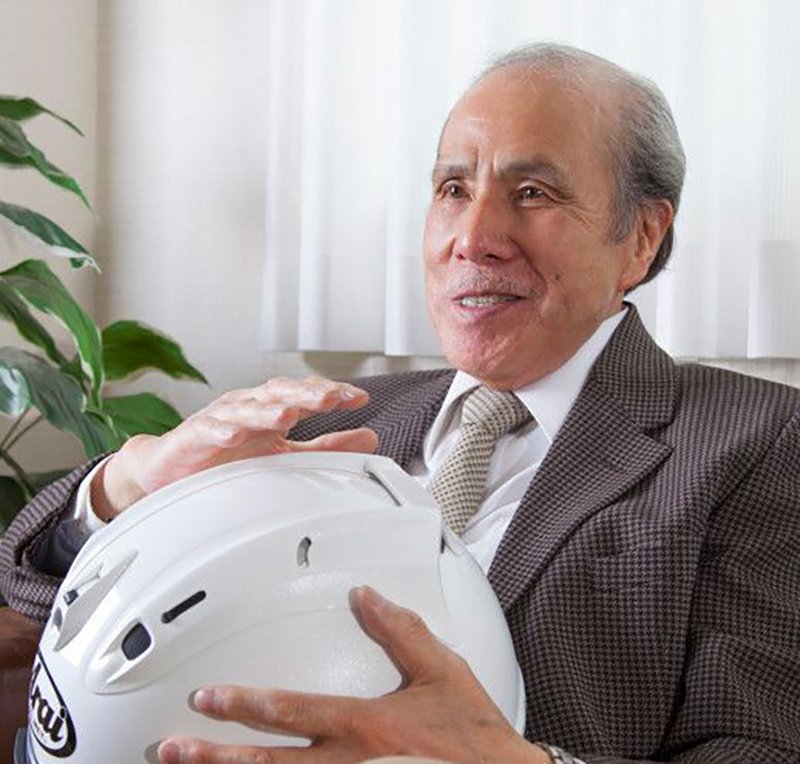
Every helmet manufacturer talks about the fact that safety sits at the very heart of everything they do. But often this is little more than rhetoric; and in reality what takes precedence are the commercial imperatives; the need to hit price points, to achieve volumes and to preserve margins. And so, whilst espousing a message about protection, their key objective is often more about taking a larger slice of the volume end of the market. (After all that’s what their venture-capital owners are demanding).
Arai doesn’t do this. They won’t use cheaper materials to hit lower price points. Arai make a helmet, and it costs what it costs. It’s that simple. This might, of course, explain why their helmets are a bit more expensive!
Safety, particularly in the context of racing, is what motivates Arai. Back in the seventies and eighties Arai developed the conviction that the best shape for the shell of a motorcycle shell was smooth and round like the shell of an egg. Not only was this a naturally strong shape, but the smoothness of the shape meant that when it hit the road surface it did not dig in and rotate. Arai termed this phenomenon ‘Glancing Off’. Even the company's new adventure offering, the Arai Tour-X5 helmet has a very round shell shape but with added ventilation and added peak!
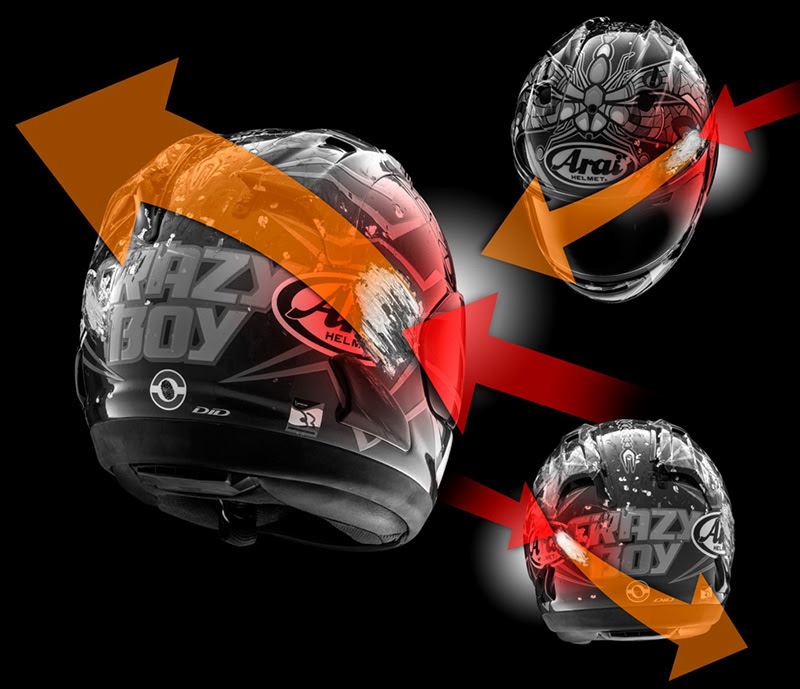
Despite the evidence of this, most helmet manufacturers, in the search for cutting-edge design and fashionability, gave their helmets an array of sharp edges and angles. Arai, of course, refused to go with the flow, unwilling to abandon its philosophy in the pursuit of market popularity.
Ironically, the new ECE standard now recognises what Arai has been telling us all along. The new test regime now incorporates a test for angled impacts, because it is now accepted that these oblique impacts can cause the brain to twist in the skull. This twisting can create tears and lesions that lead to brain damage every bit as serious as direct impacts. And so now we have a situation where helmet shells of the future are probably going to have to become more rounded to meet the standard. Just like an Arai helmet!
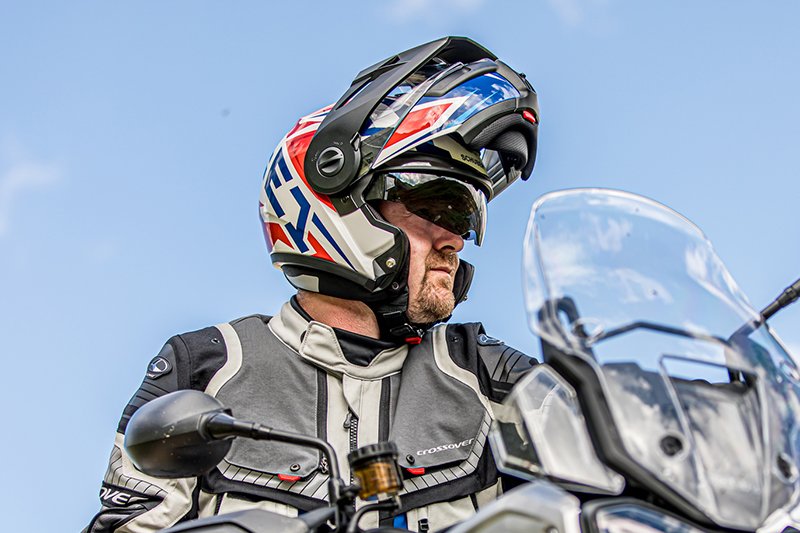
It is this same adherence to fundamental principles that causes Arai to eschew popular developments such as flip-up chin bars, drop-down sun visors and integrated comms. And they’ve done this despite the fact that many riders consider a drop-down visor to be a mandatory feature, despite the fact that the fastest growing sector at the premium end of the market is flip-lids, and despite the fact that the demand for comms. in the touring market is huge. Arai is simply having none of it. And on one level one has to admire this.
Arai is about racing. They make the best quality, safest helmets so as to protect their racers, and it’s a philosophy they are not prepared to compromise. You want an Arai helmet, you buy a helmet the way they want to make it. It’s that simple.
There are few companies in any field that are so principled. In the next section, where I am going to talk about Shoei, I will give further weight to the argument that Arai’s helmets are the safest you can buy. But let me sum it up like this. If I read my horoscope tomorrow morning, and it told me that I would come off my bike at a trackday at Donington Park, and would hit my head at speed against something hard, I would want to be in an Arai.
I am not back pedalling here. The best helmet brand, the brand that makes the safest and best quality helmets is Arai. No argument. But the question is whether their helmets are too uncompromising for the road.
The first standard to which Arai helmets were accredited back in the 1960s was the Snell standard in the USA. It is still an impressive standard; in some regards it is still superior to the latest 22-06 standard. But it was originally conceived as a standard for car racing helmets.
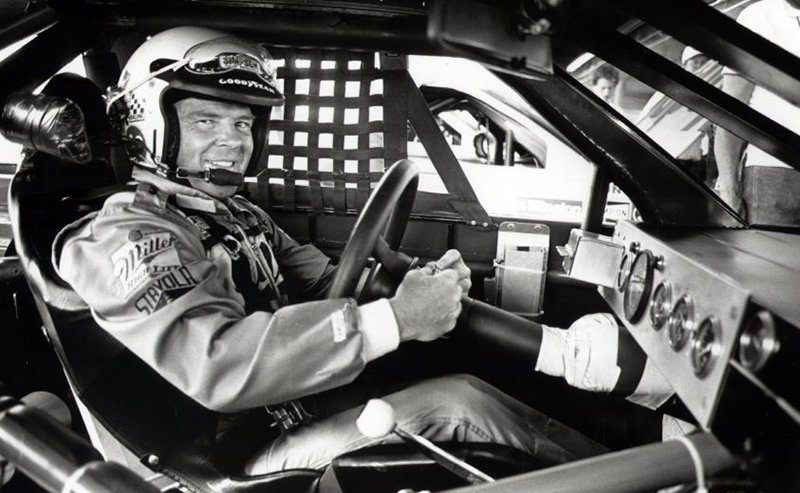
In car racing in the US at that time, a major concern was the potential repeated coming together of the head with the roll cage. And it was for this reason that the Snell test required a particularly tough and thick outer shell. As a consequence, a thick shell became a significant part of an Arai helmet’s make up; and again it is one that still today sits at the heart of the thinking behind Arai’s helmets.
Now a thick shell may sound like a good thing; and on one level it is, because it means the shell won’t crack as easily even after multiple impacts. By contrast, a cracked shell is a shell that won’t give the rider the protection he needs. But thick outer shells do not easily absorb energy, especially in low speed impacts. And so to compensate for their thicker outer shells, Arais have to have an extra thick eps liner to absorb the energy of an impact.
Following so far? Well, that’s all well and good, but the net result is that Arais tend to be bigger and heavier than helmets of a similar spec. from other brands. So, for example, if we compare the 22-06 Shoei NXR2 in size Small with the new Arai Quantic, the Shoei weighs 1265 grammes; the Arai weighs 1600 grammes. They are direct competitors at the sportier end of the sports-touring market, and whilst 325 grammes is only about the same as ‘a quarter of wine gums, please mister’, that’s a lot in helmet years.
For some people the extra weight is of little concern because, let’s face it, we can all rationalise and dismiss the inconveniences we don’t want to confront. But the truth is that a heavier helmet will not be a welcome feature for most people.
Another attribute that comes out of racing is ventilation. Racers work hard. Riding a bike at speed on a track is demanding. Your heart is beating fast. You’re going to be generating heat. What you are going to need is excellent ventilation to cool you down. Which is why ventilation, again, sits at the heart of Arai’s thinking.
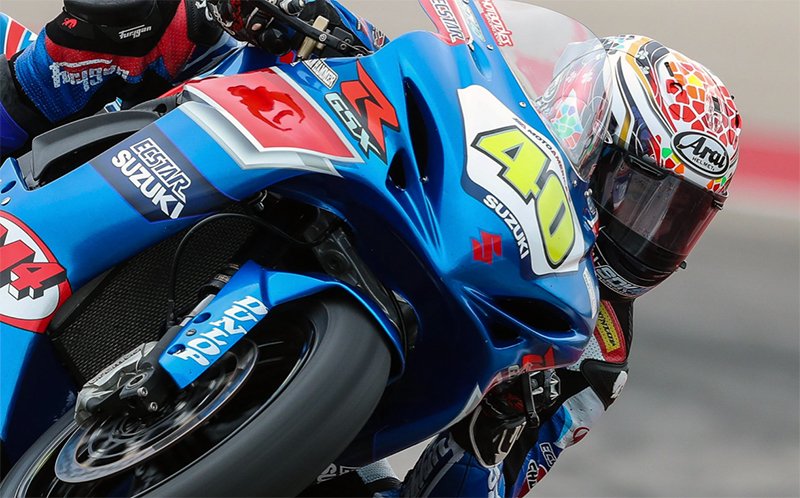
The problem with this level of air streaming into a helmet is that it can create too much noise. But Arai has never seen this as a major priority. Arai, first and foremost, make racing helmets. Noise is not their primary concern. All riders wear earplugs, anyway. For them there is no conflict. Keeping the rider cool is more important than protecting his ears. For the quietest helmet on the market you would probably go for a Schuberth helmet. Schuberth have their own wind tunnel at the factory specifically to work on airflow and reducing the noise levels. A flip lid such as the Schuberth C5 helmet will be the pick of the crop in terms of being a quiet lid.
Now, of course, Arai pretends to make touring helmets, and one expects a touring helmet to be quieter, but if you look closely all Arais are just variations on racing helmets. Look at any Arai full-face, and they all look pretty similar, albeit with different stick-on spoilers and aerofoils. Sometimes the more touring-oriented models are just previous-generation racing helmets. But there’s no disguising the Arai DNA. It’s all about about going around in circles as fast as possible.
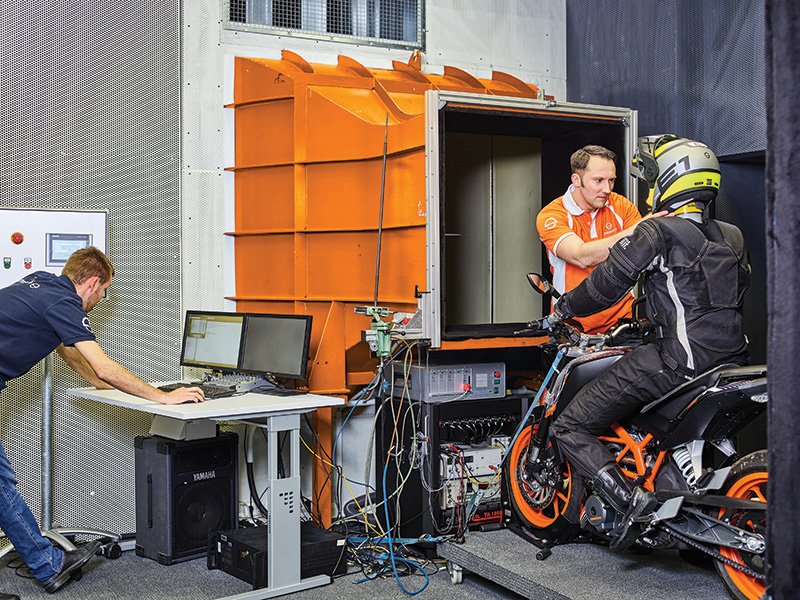
The downside for the wearer is that Arais can be pretty noisy. Those who want justify their love for their Arai will try and deny it, but Arais are noisy, and always have been. They don’t use wind tunnels in the factory in Saitama to see how they can reduce noise. They use wind tunnels to see how they can vary lift and drag to benefit the racer. Which presumably is why Arai was proud to proclaim that their new Quantic sports-touring helmet was still stable at over 180 mph! (Which means that their sports-touring bike is a whole lot faster than mine)!
So, Arais tend to be a bit heavy and a bit noisy, but for many riders the reason not to go for an Arai is that you will never get a drop-down sun visor, you will never get a flip-up chin bar and you will never get the convenience of integrated comms. Now if you have broad muscular shoulders, have earplugs or are deaf already, if you like wearing cool shades and don’t want a sun visor or a flip, and if a neater, safer comms. solution mean nothing to you, then an Arai may be for you.
But for many riders these things are more than just nice to have. If you commute west to east in the morning and east to west in the evening you might feel you need a sun visor. If you do lots of miles, you might appreciate a quiet helmet. If you ride in town or in hot countries, you might prefer a flip lid. And if any of these are important to you, you will probably not want an Arai.
Which brings me to my overall conclusion. Shoei and Arai make the world’s best helmets. Arai takes the laurels when it comes, in my view, to build quality and safety. And for trackdays and for wearing on your sportsbike, I can see why anybody might want to wear an Arai.
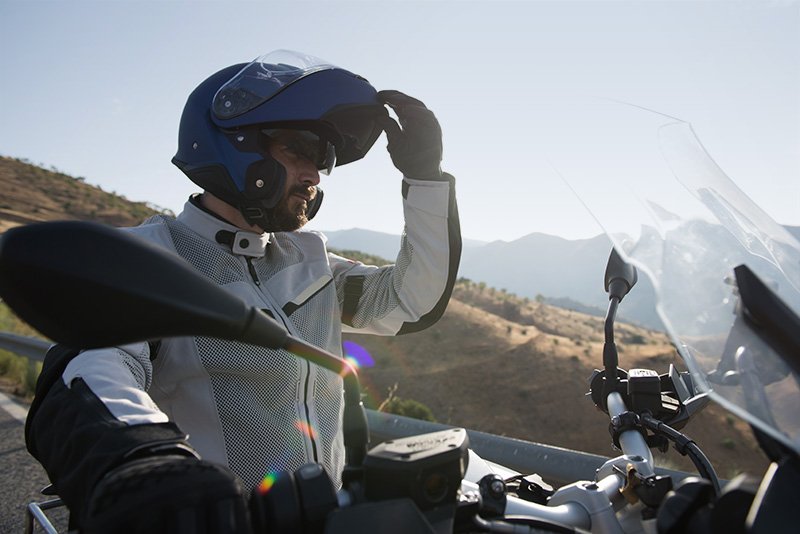
But for the road rider who wants a superbly protective helmet combined with some of the conveniences that make riding a more relaxing and enjoyable experience, then it would be Shoei that gets my vote. Arais are amazing, but they’re thinly disguised race helmets. Shoei, even though they do make some fantastic race helmets, are more open to compromise. They still make superbly protective helmets, but they understand the needs of the road rider and therefore, for by far the majority of riders, I believe that it is Shoei that makes the best helmet. For long distance tourers and commuters I would go further to suggest that is probably a Shoei Neotec 3 helmet.
Let me put it like this. I wake up. I read my horoscope. I will have an accident and bang my head tomorrow afternoon on a track day up at Donington, a three hour ride from the shop here in Guildford. I will pack my Arai for the circuit, but for my ride up there and back I would want to be wearing a Shoei helmet!
Need help choosing a helmet? We have a great article: how to choose a motorcycle helmet.
Share this story
































































